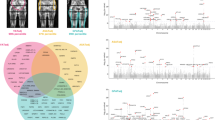Abstract
OBJECTIVES: To assess reproducibility, expressed as both inter-observer variability and intra-observer variability, of fat area measurements on images obtained by magnetic resonance (MR); to compare variability between fat area measurements, calculated from a single image per body region and from the average fat area of three images, and to determine reproducibility of image acquisition at the abdominal level.
SUBJECTS: Thirty young, non-obese subjects (reproducibility of image analysis) and nine young, non-obese subjects (reproducibility of image acquisition).
METHODS: Three MR images at the level of the abdomen (in 30 subjects) and at the level of the hip and thigh (in 14 of them). Quantification of subcutaneous fat depots (abdomen, hip and thigh) and visceral fat depots using an image-analyzing computer program. Assessment of variability of image analysis for fat area measurements between two observers and within observers. Assessment of reproducibility of image acquisition at the abdominal level (in nine subjects).
RESULTS: Subcutaneous fat areas in all body regions were quantified with coefficients of variation (CV) ranging from only 2.1%–4.9%. By contrast, visceral fat area measurements showed markedly higher CVs (range: 9.4%–17.6%). Moreover, relative variability was much larger in small visceral fat areas (CVs up to 25.6%). The majority of CVs, calculated for intra-observer variability and calculated from the average fat area measurements of three images, was lower than calculated for inter-observer variability and for one single image, respectively. In particular, for the visceral fat depot, this reduction in variability had practical consequences for the number of subjects required for a study. Variation of repeated image acquisition was in the same range as variation of repeated measurements on the same image.
CONCLUSION: One image per body site is sufficient to obtain a reliable estimate of subcutaneous fat depots. For estimations of the visceral fat depot, the average area measurements of three images reduces variability and increases statistical power. The availability of one single experienced observer during a study adds to accuracy.
This is a preview of subscription content, access via your institution
Access options
Subscribe to this journal
Receive 12 print issues and online access
$259.00 per year
only $21.58 per issue
Buy this article
- Purchase on SpringerLink
- Instant access to full article PDF
Prices may be subject to local taxes which are calculated during checkout
Similar content being viewed by others
Author information
Authors and Affiliations
Rights and permissions
About this article
Cite this article
Elbers, J., Haumann, G., Asscheman, H. et al. Reproducibility of fat area measurements in young, non-obese subjects by computerized analysis of magnetic resonance images. Int J Obes 21, 1121–1129 (1997). https://doi.org/10.1038/sj.ijo.0800525
Received:
Revised:
Accepted:
Issue date:
DOI: https://doi.org/10.1038/sj.ijo.0800525
Keywords
This article is cited by
-
Automatic segmentation of whole-body adipose tissue from magnetic resonance fat fraction images based on machine learning
Magnetic Resonance Materials in Physics, Biology and Medicine (2022)
-
Automated Separation of Visceral and Subcutaneous Adiposity in In Vivo Microcomputed Tomographies of Mice
Journal of Digital Imaging (2009)
-
Quantitative comparison and evaluation of software packages for assessment of abdominal adipose tissue distribution by magnetic resonance imaging
International Journal of Obesity (2008)
-
NIH ImageJ and Slice‐O‐Matic Computed Tomography Imaging Software to Quantify Soft Tissue
Obesity (2007)
-
Comparison of Methods for Assessing Abdominal Adipose Tissue from Magnetic Resonance Images
Obesity (2007)



